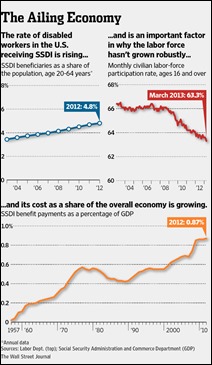What do you know about Social Security Disability?
Posted By RichC on April 11, 2013
If you are the average healthy American who is working or independently seeking a job, you might be as unknowledgeable as I am when it comes to knowing anything about government benefits. I’ve generally assumed that those who are “disabled” are  not capable of functioning or were disabled on the job due injury. What I did not know was that workers are collecting Social Security Disability based on their ability to perform the job they “were” in and that there is a disincentive to take on different kinds of work or retraining.
not capable of functioning or were disabled on the job due injury. What I did not know was that workers are collecting Social Security Disability based on their ability to perform the job they “were” in and that there is a disincentive to take on different kinds of work or retraining.
I have also been reading that since the recession began in 2008 that the roles of those collecting Social Security Disability have ballooned. This is evidenced by the quirky reporting numbers that the United States Department of Labor regularly reports, including the unemployment numbers (currently at 7.6%) as compared to the workforce participation rate. While the employment number seems to be improving … although ever so slowly … the participation rate (percentage of Americans working) is at a 40 year low. This combination indicates that people are dropping out of the workforce and aren’t even looking for work. Welfare, food stamps, early retirement and Social Security Disability payments have all risen and are continuing to rise. (click for larger WSJ graphic)
A WSJ article hints at the problem:
Workers Stuck in Disability Stunt Economic Recovery
The unexpectedly large number of American workers who piled into the Social Security Administration’s disability program during the recession and its aftermath threatens to cost the economy tens of billions a year in lost wages and diminished tax revenues.
Signs of the problem surfaced Friday, in a dismal jobs report that showed U.S. labor force participation rates falling last month to the lowest levels since 1979, the wrong direction for an economy that instead needs new legions of working men and women to drive growth and sustain a baby boomer generation headed to retirement.
Michael Feroli, chief U.S. economist for J.P. Morgan estimates that since the recession, the worker flight to the Social Security Disability Insurance program accounts for as much as a quarter of the puzzling drop in participation rates, a labor exodus with far-reaching economic consequences.
The unemployment rate in Friday’s report fell to a four-year low of 7.6%, which most times signals job growth. This time it reflected workers leaving the workforce, a problem that could persist: Economists say relatively few people are likely to trade their disability checks for paychecks, in part because the program doesn’t give much incentive to leave.
Former truck driver James Ottesen, who began receiving monthly payments in 2009, said, "I’m not real happy" about being on disability. "It kind of reminds me of welfare." He said he would "like to get re-educated to do something" because "my body is broke but my mind is not."
But even if the 53-year-old Ohio man learned of a job he could do with herniated discs, he said, the government disability program feels like "a blanket covering you, and to walk out from it…at my age, it’s a little intimidating."

Comments